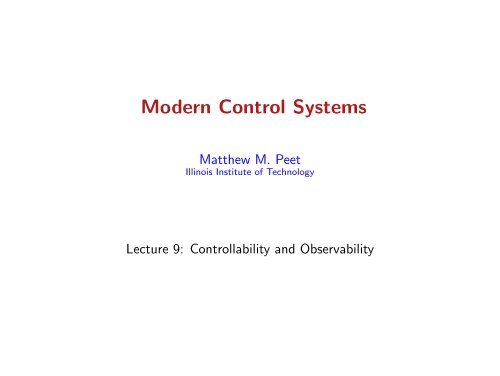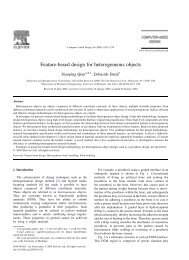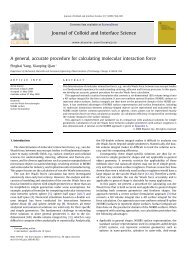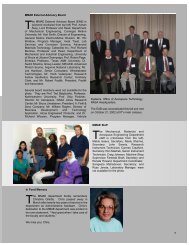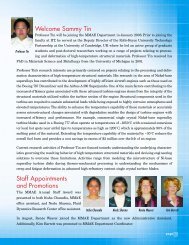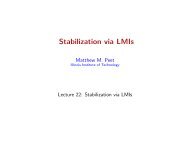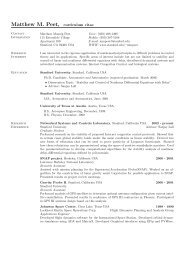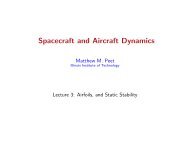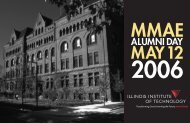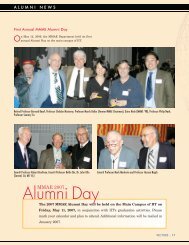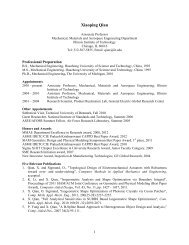Lecture 9: Controllability and Observability - Illinois Institute of ...
Lecture 9: Controllability and Observability - Illinois Institute of ...
Lecture 9: Controllability and Observability - Illinois Institute of ...
You also want an ePaper? Increase the reach of your titles
YUMPU automatically turns print PDFs into web optimized ePapers that Google loves.
Modern Control Systems<br />
Matthew M. Peet<br />
<strong>Illinois</strong> <strong>Institute</strong> <strong>of</strong> Technology<br />
<strong>Lecture</strong> 9: <strong>Controllability</strong> <strong>and</strong> <strong>Observability</strong>
<strong>Controllability</strong><br />
We would like to prove that<br />
To do this, we will prove that<br />
• Im(W t ) ⊂ R t<br />
• R t ⊂ Im(C(A, B))<br />
• Im(C(A, B)) ⊂ Im(W t )<br />
So far, we have show that<br />
R t = Im(W t ) = Im(C(A, B))<br />
Next, we will show that<br />
R t ⊂ C AB<br />
Im(W t ) ⊂ R t<br />
M. Peet <strong>Lecture</strong> 9: <strong>Controllability</strong> 2 / 15
This pro<strong>of</strong> M. Peet is especially useful, as it gives the<strong>Lecture</strong> control 9: <strong>Controllability</strong> input which will get us to x3 / 15<br />
<strong>Controllability</strong>: Im(W t ) ⊂ R t<br />
Theorem 1.<br />
Im(W t ) ⊂ R t<br />
Pro<strong>of</strong>.<br />
First, suppose that x ∈ Im(W t ) for some t > 0. Then x = W t z for some z.<br />
• Now let u(s) = B T e AT (t−s) z. Then<br />
Γ t u =<br />
=<br />
∫ t<br />
0<br />
∫ t<br />
= W t z = x<br />
• Thus x ∈ Im(Γ t ) = R t .<br />
We conclude that Im(W t ) ⊂ R t<br />
0<br />
e A(t−s) Bu(s)ds<br />
e A(t−s) BB T e AT (t−s) zds
Pro<strong>of</strong> by Contradiction: Im(C(A, B)) ⊂ Im(W t )<br />
The last pro<strong>of</strong> is a pro<strong>of</strong> by contradiction.<br />
Once you eliminate the impossible, whatever remains, no matter how<br />
improbable, must be the truth.<br />
There are two mutually exclusive possibilities<br />
1. x ∈ Im(C(A, B)) ⊂ Im(W t )<br />
2. There exists some x ∈ Im(C(A, B)) such that x ∉ Im(W t ) .<br />
We eliminate the second possibility by showing that:<br />
• If x ∉ Im(W t ) then x ∉ Im(C(A, B)).<br />
In shorth<strong>and</strong>:<br />
(¬2 ⇒ ¬1) ⇔ (1 → 2)<br />
An alternative would be to find an x which disproves the second possibility.<br />
M. Peet <strong>Lecture</strong> 9: <strong>Controllability</strong> 4 / 15
Pro<strong>of</strong> by Contradiction: Im(C(A, B)) ⊂ Im(W t )<br />
Theorem 2.<br />
Im(C(A, B)) ⊂ Im(W t ).<br />
Pro<strong>of</strong>.<br />
Suppose x ∉ Im(W t ). Then x ∈ Im(W t ) ⊥ .<br />
• As we have shown, this means x ∈ ker(W t ), so W t x = 0.<br />
• Thus<br />
x T W t x =<br />
=<br />
∫ t<br />
0<br />
∫ t<br />
0<br />
x T e A(t−s) BB T e AT (t−s) xds<br />
u(s) T u(s)ds = 0<br />
where u(s) = B T e AT (t−s) x.<br />
• This implies u(s) = B T e AT (t−s) x = 0 for all s ∈ [0, t].<br />
M. Peet <strong>Lecture</strong> 9: <strong>Controllability</strong> 5 / 15
Pro<strong>of</strong> by Contradiction: Im(C(A, B)) ⊂ Im(W t )<br />
Pro<strong>of</strong>.<br />
• This means that for all s ∈ [0, t],<br />
d k<br />
ds k BT e AT s x = B T ( A T ) k<br />
e<br />
A T s x = 0<br />
• At s = 0, this implies B T ( A T ) k<br />
x = 0 for all k.<br />
• We conclude that<br />
x T [ B AB · · · A n−1 B ] = 0<br />
• Thus C(A, B) T x = 0, so x ∈ ker C(A, B) T . As before, this means<br />
x ∈ Im(C(A, B)) ⊥ .<br />
• We conclude that x ∉ Im(C(A, B)). This proves by contradiction that<br />
Im(C(A, B)) ⊂ Im(W t ).<br />
M. Peet <strong>Lecture</strong> 9: <strong>Controllability</strong> 6 / 15
Summary: R t = Im(W t ) = Im(C(A, B))<br />
We have shown that<br />
R t = Im(W t ) = Im(C(A, B))<br />
Moreover, we have shown that for any x d ∈ R Tf , we can find a controller<br />
• Choose any z such that x d = W Tf z. (z = W −1<br />
T f<br />
x if W Tf is invertible)<br />
• Let u(t) = B T e AT (T f −t) z.<br />
• Then the system ẋ(t) = Ax(t) + B(t) with x(0) = 0 has solution with<br />
x(T f ) = x d .<br />
• x d = Γ Tf u.<br />
M. Peet <strong>Lecture</strong> 9: <strong>Controllability</strong> 7 / 15
Representation <strong>and</strong> <strong>Controllability</strong><br />
Question: Is the representation (A, B, C, D) <strong>of</strong> the system y = Gu,<br />
unique<br />
ẋ(t) = Ax(t) + Bu(t)<br />
y(t) = Cx(t) + Du(t)<br />
Question: Do there exist (Â, ˆB, Ĉ, ˆD) such that y <strong>and</strong> u also satisfy,<br />
ẋ(t) = Âx(t) + ˆBu(t)<br />
y(t) = Ĉx(t) + ˆDu(t)<br />
Answer: Of Course! Recall the similarity transform: z(t) = T x(t) for any<br />
invertible T . Then y <strong>and</strong> u also satisfy,<br />
ż(t) = T ẋ(t) = T Ax(t) + T Bu(t)<br />
= T AT −1 z(t) + T Bu(t)<br />
y(t) = Cx(t) + Du(t)<br />
= CT −1 x(t) + Du(t)<br />
M. Peet <strong>Lecture</strong> 9: <strong>Controllability</strong> 8 / 15
Representation <strong>and</strong> <strong>Controllability</strong><br />
Thus the pair (T AT −1 , T B, CT −1 , D) is also a representation <strong>of</strong> the map<br />
y = Gu.<br />
• Furthermore x(t) → 0 if <strong>and</strong> only if z(t) → 0.<br />
• So internal stability is unaffected.<br />
<strong>Controllability</strong> is Unaffected:<br />
C(T AT −1 , T B) = [ T B T AT −1 T B T AT −1 T AT −1 T B · · · T A n−1 B ]<br />
= T C(A, B)<br />
M. Peet <strong>Lecture</strong> 9: <strong>Controllability</strong> 9 / 15
Invariant Subspaces<br />
Definition 3.<br />
A subspace, W ⊂ X, is Invariant under the operator A : X → X if x ∈ W<br />
implies Ax ∈ W .<br />
For a linear operator, only subspaces can be invariant.<br />
Proposition 1.<br />
If W if A-invariant, then there exists an invertible T , such that<br />
]<br />
[ [Ā11<br />
T AT −1 Ā<br />
=<br />
12<br />
I<br />
<strong>and</strong> T W = Im<br />
Ā 21 Ā 22 0]<br />
That is, for any x ∈ W , T x =<br />
] [¯x1<br />
, which is clearly<br />
0<br />
Ā-invariant.<br />
M. Peet <strong>Lecture</strong> 9: <strong>Controllability</strong> 10 / 15
Invariant Subspaces<br />
Proposition 2.<br />
C AB is A-invariant.<br />
Pro<strong>of</strong>.<br />
The pro<strong>of</strong> is direct<br />
A · C(A, B) = A [ B AB · · · A n−1 B ] = [ AB A 2 B · · · A n B ]<br />
But, by Cayley-Hamilton,<br />
A n =<br />
n−1<br />
∑<br />
a i A i<br />
so if x ∈ C AB , there exists a z such that<br />
Ax = A [ B AB · · · A n−1 B ] z<br />
⎡<br />
⎤<br />
z n a 0<br />
= [ B · · · A n−1 B ] z 1 + z n a 1<br />
⎢<br />
⎥<br />
⎣ . ⎦ ∈ C AB<br />
z n+1 + z n a n−1<br />
i=0<br />
M. Peet <strong>Lecture</strong> 9: <strong>Controllability</strong> 11 / 15
<strong>Controllability</strong> Form<br />
Since C AB is an invariant subspace <strong>of</strong> A, there exists an invertible T such that<br />
]<br />
[Ā11<br />
T AT −1 Ā<br />
=<br />
12<br />
0 Ā 22<br />
[¯x<br />
<strong>and</strong> T x = for any x ∈ C<br />
0]<br />
AB .<br />
• Clearly B ∈ C AB .<br />
[ ] ¯B1<br />
• Thus T B = .<br />
0<br />
Definition 4.<br />
The pair (A, B) is in <strong>Controllability</strong> Form when<br />
[ ]<br />
A11 A<br />
A =<br />
12<br />
<strong>and</strong> B =<br />
0 A 22<br />
<strong>and</strong> the pair (A 11 , B 1 ) is controllable.<br />
[ ]<br />
B1<br />
,<br />
0<br />
M. Peet <strong>Lecture</strong> 9: <strong>Controllability</strong> 12 / 15
<strong>Controllability</strong> Form<br />
When a system is in controllability form, the dynamics have special structure<br />
ẋ 1 (t) = A 11 x 1 (t) + A 12 x 2 (t) + B 1 u(t)<br />
ẋ 2 (t) = A 22 x 2 (t)<br />
The uncontrolled dynamics are autonomous.<br />
• Cannot be stabilized or controlled.<br />
We can formulate a procedure for putting a system in <strong>Controllability</strong> Form<br />
1. Find an orthonormal basis, [ ]<br />
v 1 · · · v r for CAB .<br />
2. Complete the basis in R n : [ ]<br />
v r+1 · · · v n .<br />
3. Define T = [ ]<br />
v 1 · · · v n .<br />
4. Construct Ā = T AT −1 <strong>and</strong> ¯B = T B<br />
◮ Works for ANY invariant subspace.<br />
M. Peet <strong>Lecture</strong> 9: <strong>Controllability</strong> 13 / 15
<strong>Controllability</strong> Form<br />
Example<br />
Let<br />
⎡<br />
1 −1<br />
⎤<br />
0<br />
⎡ ⎤<br />
1<br />
A = ⎣−1 1 0 ⎦ <strong>and</strong> B = ⎣0⎦<br />
0 0 −1<br />
0<br />
Construct C(A, B) = [ B AB A 2 B ] .<br />
⎡<br />
1 −1<br />
⎤ ⎡ ⎤<br />
0 1<br />
⎡ ⎤<br />
1<br />
AB = ⎣−1 1 0 ⎦ ⎣0⎦ = ⎣−1⎦ ,<br />
0 0 −1 0 0<br />
⎡<br />
⎤ ⎡ ⎤ ⎡ ⎤<br />
1 −1 0 1 0<br />
A 2 B = A(AB) = ⎣−1 1 0 ⎦ ⎣−1⎦ = ⎣0⎦<br />
0 0 −1 0 0<br />
Thus<br />
⎡<br />
1 1<br />
⎤<br />
0<br />
C(A, B) = ⎣0 −1 0⎦<br />
0 0 0<br />
Thus rank C(A, B) = 2 < n = 3 which means not controllable.<br />
M. Peet <strong>Lecture</strong> 9: <strong>Controllability</strong> 14 / 15
<strong>Controllability</strong> Form<br />
Example Continued<br />
Using Gramm-Schmidt, we can construct an orthonormal basis for C AB<br />
⎧⎡<br />
⎤ ⎡ ⎤⎫<br />
⎧⎡<br />
⎤ ⎡ ⎤⎫<br />
⎨ 1 1 ⎬ ⎨ 1 0 ⎬<br />
C AB = span ⎣0⎦ , ⎣−1⎦<br />
⎩<br />
⎭ = span ⎣0⎦ , ⎣1⎦<br />
⎩ ⎭ = span {v 1, v 2 }<br />
0 0<br />
0 0<br />
Let v 3 = [ 0 0 1 ] T<br />
. Then<br />
⎡<br />
T −1 = ⎣ 1 0 0<br />
⎤<br />
0 1 0⎦ = I<br />
0 0 1<br />
So T = I, which is because the system is already in controllability form. We<br />
could also have used<br />
⎡<br />
0 1<br />
⎤<br />
0<br />
⎡<br />
1 −1<br />
⎤<br />
0<br />
T −1 = ⎣1 0 0⎦ to get T AT −1 = ⎣−1 1 0 ⎦ = A<br />
0 0 1<br />
0 0 −1<br />
M. Peet <strong>Lecture</strong> 9: <strong>Controllability</strong> 15 / 15


